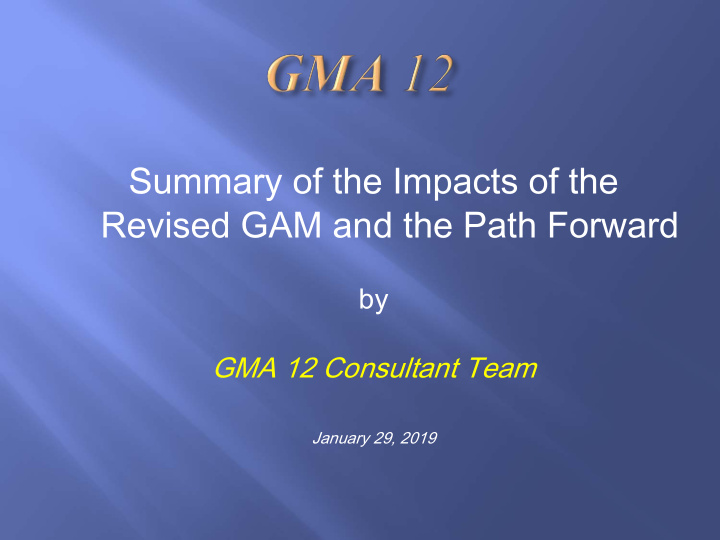



Summary of the Impacts of the Revised GAM and the Path Forward by GMA 12 Consultant Team January 29, 2019
¨ Addition of two new model layers: ¡ River alluvium ¡ Shallow groundwater flow system ¨ Updating of location and characteristics of faults ¨ Calibration time period 1930-2010 ¨ Grid refinement around rivers and streams ¨ Improving surface water-groundwater interactions (grid refinement, two new layers) ¨ Some localized changes in aquifer properties and structure
¨ Task was to run the previous amount and distribution of pumpage in the updated GAM and compare the results ¨ Direct comparison of results not possible for numerous reasons: ¡ Calibration time period through 2010 ¡ Refinement of the grid around rivers and streams ¡ Additional of two new model layers ¨ Methods developed to convert and assess the well file from the previous GAM are different than the methods that should be used moving forward
¨ Previous GAM calibrated through 1999 ¨ Predictive run was 2000 to 2070 ¨ All DFC statements were therefore stated as “Drawdowns from January 2000 to [future date]” ¨ Updated GAM calibrated through 2010 ¨ Predictive run is now 2011 to 2070 ¨ 2000-2010 will not be included in DFCs for updated GAM
¨ Use only the water levels/drawdowns in shallow flow system (Layer 2) ¨ Use only the water levels/drawdowns in the cell representing the deeper flow system ¨ Use an average of the water levels/ drawdowns in both the shallow and deep flow systems (straight or weighted average) ¨ Use the maximum of drawdowns in the shallow and deep flow systems
¨ Use only the water levels/drawdowns in shallow flow system (Layer 2) ¨ Use only the water levels/drawdowns in the cell representing the deeper flow system ¨ Use an average of the water levels/ drawdowns in both the shallow and deep flow systems (straight or weighted average) ¨ Use the maximum of drawdowns in the shallow and deep flow systems
¨ Several significant differences between the previous and updated GAMs- faults, calibration time period, grid, layering ¨ Updated GAM significantly impacts calculated drawdowns from previous GAM run ¨ It was not possible to do an exact comparison of the previous amount and distribution of pumpage (MAGs) in the updated GAM ¡ Multiple ways that PS-12 can be converted for use in the updated GAM ¡ Multiple ways to evaluate results and calculate drawdowns
¨ It is apparent that all users (GMA 12, GCDs, TWDB, etc.) must come to a consensus as to how the model will be set up and used for joint groundwater planning ¨ Recommend pumping be included in all layers including Layers 1 and 2 ¨ Recommend using the maximum of drawdowns in the shallow and deep flow systems to estimate DFCs
¨ Determine how results from GAM will be analyzed ¨ Predictive well (WEL) file will be based on the 2010 data from the historic calibration well file ¨ GCDs will estimate pumpage for their districts for 2011-2017 ¨ Similar to the last round, we will create well files based on an anticipated demand increase and for all permits fully produced for all of predictive time period (2018-2070) and assess the results
¨ Winter 2019- Current Meeting ¨ Spring 2019- Finish “interim” pumpage (2011- 2017), other discussions ¨ Summer 2019- Finish two predictive GAM runs (anticipated pumpage, full production of permits), discuss non-relevant aquifers ¨ Fall 2019- Additional GAM runs, discussion of nine factors, declaration of non-relevant aquifers
¨ Winter 2020- Additional GAM runs, discussion of nine factors ¨ Spring 2020- Final decisions on GAM runs, final discussions on nine factors ¨ Summer 2020- Discuss and finalize proposed DFCs ¨ Fall 2020-Adopt proposed DFCs (deadline May 1, 2021)
¨ Winter 2021- GCDs public comments and public hearing ¨ Spring 2021- Discuss public comment received ¨ Summer 2021- Adopt final DFCs (deadline Jan. 5, 2022, discuss draft Explanatory Report ¨ Fall 2021- Adopt final Explanatory Report
Recommend
More recommend